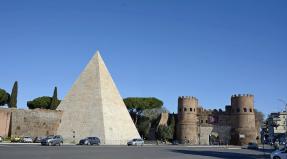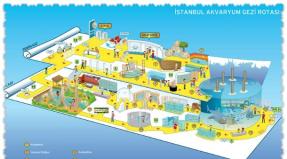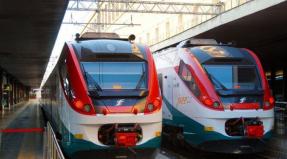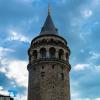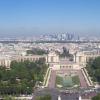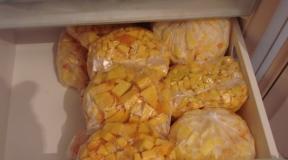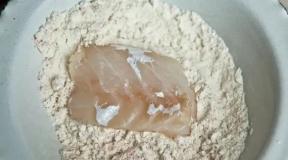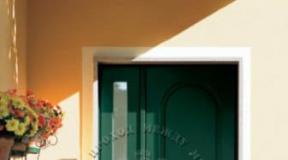Belleville quarter in Paris. Belleville quarter in Paris
The Belleville quarter, which became part of Paris only in 1860, is located along the western spurs of the ridge, which rises from the side of the river in the Bercy region and reaches a height of 128 meters at the place where the holidays are held in Belleville.
This place is the highest point in Paris after Montmartre. This area is somewhat neglected and even roguish in places, but there are also charming corners here.
Belleville has the most diverse crowd in Paris: a mixture of traditional working class, different ethnic communities and numerous students and artists, while in other areas the picture is quite different.
The easiest and fastest way to get to Belleville quarter(Quartier de Belleville) is to take bus number 26 from the North Station, getting off and on the way again at the main points of the route along Simon-Bolivar Avenue and Pirene Street, next to which the path runs along the entire ridge to Porte de Vincennes ( the Vincennes gate).
It is best to start exploring the area with buttes-chaumont park(Parc des Buttes Chaumont), which is located north of the hills of Belleville. The park was laid out Baron Osman in the 1860s to hide the abandoned labyrinths of former quarries, garbage dumps and shacks.
In place of this unsightly landscape, a fabulous park soon arose. There is a grotto with a cascade and artificial stalactites, and even a picturesque lake, in the center of which there is a huge rock crowned with an elegant Corinthian temple. You can cross the lake on a suspension bridge or take a shorter route on the Suicide Bridge (Pont de Suicid).
Louis Aragon, a writer and well-known leader of the French Communist Party, wrote about this bridge in his novel The Peasant of Paris: no intention of killing themselves, they suddenly succumbed to the temptation to throw themselves into the abyss ... ".
From the bridge, you will have wonderful views of Basilica of the Sacré Coeur and further, and on the lake it is pleasant to ride a boat. Here you are also allowed to lie on the grass, which is generally not typical for Paris.
Suburb (quarter) Belleville
The suburb of Belleville, which means "beautiful city" in translation, is not at all as beautiful as its name suggests. But still, you should take a glimpse of a piece of old Paris, because among the inexpressive residential complexes there are still old streets that have not changed much since the 1930s.
To the east of the Buttes-Chaumont park, in the area between Rue Crimet and Rennes-et-Danube (“Rhine and Danube”), dozens of paved, green cab yards depart from Miguel Hidalgo, Generale Brunet, Liberte and Egalite streets ( called a villa). Going south, you will find yourself on the main street of the quarter - Belleville Street.
Not far from its highest part is Fet Square, where the market is still open, but not as festive as before. Once a verdant countryside, it's now crammed with concrete towers and shopping malls, symbols of the unimaginative planned redevelopment of the former shantytown that was implemented in the 1960s and 1970s.
Nevertheless, this area is quite green, it even has a small park with a rotunda, lawns and trees; on fine days, locals like to sit on the benches here. As the rue de Belleville, in the area of the Saint-Jean-Baptiste-de-Belleville church, among sausage shops and bakeries, goes steeper and steeper, you feel that this can be the lively main street of any French provincial town.
Continuing on along Belleville street past Pyrenees street and turning left around the corner onto Julien-Delacroix street, you will find yourself in front of a square that was laid out in a wasteland. On the open wall of one of the residential buildings, a large mural depicting a detective is visible, and next to it, the neorealist sculptor Ben created a "deceptive" image - a sign that says "You should not believe the words."
Below the Rue Pirene, you can see the remains of the old Belleville, which continue to exist along with new buildings. And on Belleville Street itself, on the wall of house number 72, there is a commemorative plaque mentioning the name of the legendary French singer Edith Piaf. It is said that she was born right here, under a street lamp.
A little off the rue Belleville is the cobbled rue Pia, rising past the beautiful wrought-iron gates of the overgrown Villa Otoz to Belleville park(Parc de Belleville), created in the mid-1990s. From the terrace at the crossroads of rue Anvierge, you have a stunning view of the city, which is especially beautiful at sunset, and at your feet this small park descends in the form of rows of terraces and small waterfalls.

Continuing further, you will see a path that passes a tiny vineyard and, crossing the top of the park, ends with steps leading to the Rue Couronne. In order to better feel the change in the atmosphere in this quarter, wander through the surrounding streets - Marc Street, Anvierge Street, Cascade Street.
In their overgrown gardens, two or three beautiful old houses can be seen, along with new houses, stretching along the heights and bends of the streets and alleys between them. Between the lower part of the park and Belleville Boulevard, the original development of the quarter and active street life have almost completely disappeared, despite the concerted actions taken to preserve the old Belleville by local organizations that advocate the restoration of old buildings, against their demolition and for the preservation of old Cafe , restaurants and shops that support the traditional life of the quarter.
Rampono Street, going west from Belleville Park, is associated with the history of popular uprisings: at its intersection with Turtii Street during the Paris Commune there was the last barricade, which for fifteen minutes alone was defended by the last of the fighting Communards.
Today, these streets and boulevard showcase the great ethnic diversity of Belleville. So, on Ramponeau Street you will find kosher shops owned by Sephardic Jews from Tunisia, and at the intersection of Faubourg du Temple and Belleville Boulevard, there are dozens of Chinese restaurants and restaurants run by Turks, Greeks and immigrants from Eastern Europe.
On Belleville Boulevard, especially on Tuesday and Friday mornings, when the market is open there, you can see many women in the national clothes of Mali, Gambia and Zaire, as well as men in burnous. And all this diversity is reflected in the products sold here.
Along the boulevard Belleville, there are striking examples of modern architecture, with prominent triangles and curves, but sometimes there are also roof lines typical of 19th-century Parisian buildings. This combination of old and new continues in lower Belleville, in a large triangle of streets bounded by Boulevard Belleville, rue Faubourg du Temple (the busiest) and avenue Republic.
In this area, you will see a mixture of native French and immigrant workshops, as well as small private businesses and traditional French houses, where there are passages (passages) hidden in courtyards. Here, at 105 Rue Faubourg du Temple, is the famous Java Club, where Edith Piaf loved to perform in those days when it was a simple dance hall.
The original interior of the hall has been preserved here, but the dances and music are now predominantly Latin American. The playful high-tech glass and metal decoration at number 117 on the same street is adjacent to small private shops in the Breton courtyard. Goods here are still half the price of downtown stores, even as restaurants in the neighborhood are becoming more and more trendy.

Claude Chappe and Telegraph Street
Telegraph Street, running south from the east end of Belleville Street along Belleville Cemetery, is named after the inventor Claude Chappe, who invented the optical telegraph.
It was here, on the corner of the cemetery, that in September 1792 Chappe first tested his device. When his activities became known to everyone, he was nearly killed, because many believed that he was trying to signal the king, who at that time was kept in the Templar fortress.
However, in the end, using the invention of Chappe, two telegraph lines were drawn: from Belleville to Strasbourg and further east and from Montmartre to Lille and further north. By the end of 1840, it was possible to send a message to Cape with 27 switches in 3 minutes, and to Strasbourg with 46 switches in 7 minutes.
Schapp himself did not live to see the fruits of his labors: in 1805, his patent was challenged and the poor inventor, mad with despair, threw himself into the gutter (now his grave is located on a nearby Pere Lachaise cemetery).
Descent from Curtil
The name "Kurtil" comes from the word kurti, which means "garden" in the Picardy dialect. In the 19th century, the heights of Belleville were known as the Upper Courtille (Haut-Courtier), while the lower part of the faubourg, in the area of the Rue Faubourg du Temple and the Rue Fontaine-aux-Roi, was called the "Lower Courtille" (Basse-Courtier). In both parts there were many beer and dance halls where people liked to relax on holidays.
The biggest feasts of the year were held on the night of Mardi Gras (the popular holiday on Shrove Tuesday, the last day before Lent), when thousands of masked people took to the streets to celebrate the end of the carnival.
The next day on Ash Wednesday, which is considered the day of repentance, a crowded drunken procession descended from Belleville Hill into the city, which required up to a thousand horse-drawn carriages, and the whole event was called "Descent from Curtil".



More photos of the Belleville quarter in Paris here: Photo gallery
Belleville, a working-class district of Paris, is located on a high hill in the eastern part of the city, near the Pere Lachaise cemetery. In the middle of the century, this picturesque neighborhood was in the possession of abbeys and monasteries, and in the 18th century. the area was settled by workers from nearby quarries and vineyards.
With the development of industrial production in the capital, the population of Belleville increased rapidly, and in 1860 the area was annexed to Paris. In the days of fierce fighting for the Paris Commune, the working population of Belleville offered the most stubborn resistance to the onslaught of the Versaillese. In May 1871, the last battles took place on the streets of Belleville, ending in a brutal reprisal against the Communards. The extermination was so massive that some quarters of the 20th district of Paris became completely deserted.

At present, Belleville has lost the appearance of a working-class quarter of the last century in many places. Where only a few years ago there were narrow, dark and fetid courtyards, today modern urban planners have erected quite beautiful and elegant houses, which, however, were beyond the means of the inhabitants of the disappeared narrow streets, dead ends and courtyards.

At the same time, folk streets with their rooted proletarian traditions are still preserved here, where from time to time you can find sad reminders of the bloody days of the Paris Commune. In the northern part of the quarter, there is a picturesque park of Buttes-Chaumont on 23 hectares. In the Middle Ages, there was a city dump here, and the place was considered one of the most sinister in Paris. The park was created under Baron Osman at the end of the 19th century. artists Alphand and Barillet.
Its creators skillfully used this wild and quarried area. On Place Colonel-Fabien is the building of the Central Committee of the French Communist Party, built in 1971 by the famous Brazilian architect Oscar Niemeyer. The popular French singer Edith Piaf was born at 72 Belleville Street.
Saint-Martin-de-Belleville in France is a small alpine town and ski resort in the Three Valleys region, where you can forget about the bustle of modern megacities and completely immerse yourself in the calm atmosphere of a classic alpine village. Saint-Martin-de-Belleville is located in Savoy in the Belleville Valley and, despite its close proximity to such super popular ski centers as Méribel and Courchevel, has managed to maintain a traditional, measured way of life. Its majestic mountain landscapes combined with medieval houses create a peaceful atmosphere, and the ski slopes delight both beginners and experienced skiers. At the same time, accommodation here is much cheaper than in trendy neighboring resorts.
Business card
Trails, slopes, lifts
The elevation difference in the Saint-Martin-de-Belleville area is from 1450 to 3200 m. The resort offers guests 160 km of ski slopes, most of which belong to the easy "blue" and medium "red" categories. However, there are also six difficult "black" tracks.
For those who want to improve their skiing skills, there is a ski school and 12 training slopes, including special slopes for children. Over 400 snow cannons provide excellent snow quality.
One of the easy trails descends directly into the village, and the ski lift takes you to the nearby slopes, suitable for beginners and experienced skiers.
Great opportunities for skiing athletes await near Les Menuires, which can be reached by ski or free shuttle bus. It is here that the trails for professionals and the highest points of the valley with dizzying descents are located. For example, Sim de Caron (3195 m), from where three "black" slopes originate.
A network of 31 lifts connects the villages of the Belleville valley with each other, it can also be used to reach the other two valleys of the ski region: Les Allues and Saint-Bon.
Entertainment and active recreation
The choice of winter activities in the French Saint-Martin-de-Belleville is quite wide. Here you can go not only skiing, but also sledding, snowshoeing, snowboarding, freeriding and mountain climbing. There are 28 km of cross-country ski runs in the valley, and slalom runs near Val Thorens.
In the summer, when the ski season ends, life in the village does not stop. Guests of Saint-Martin-de-Belleville enjoy mountain hiking, paragliding and mountain biking. For curious tourists, a historical museum is open, which tells about the life of ordinary Savoyard farmers.
France is a country of romance, struggle and freedom, and Paris is a city of contrasts, which once again remind you that people here knew how to love, hate, start life anew and end it so that they would remember you for a long time. Museums, old houses and palaces attract here, but modern buildings are no less interesting. There are places where tourists from all over the world want to visit, but there are places that are afraid.
In the capital of France, you can meet people who can be safely called ethnic French, but there are also areas where the bulk of the population are representatives of other nationalities. For example, part of the 20th arrondissement of Paris - quarter Belleville (Belleville Paris).
Belleville quarter in Paris
 The first buildings on the Belle Vue hill appeared in the 12th century. It is known that even then they were surrounded by beautiful vineyards. In the Middle Ages, the territory of the modern Belleville quarter belonged to abbeys and monasteries. It was so picturesque that at one time the Parisians even chose it for Sunday walks. In addition, winemaking flourished in the village and many came here to taste the local wine.
The first buildings on the Belle Vue hill appeared in the 12th century. It is known that even then they were surrounded by beautiful vineyards. In the Middle Ages, the territory of the modern Belleville quarter belonged to abbeys and monasteries. It was so picturesque that at one time the Parisians even chose it for Sunday walks. In addition, winemaking flourished in the village and many came here to taste the local wine.
Starting from the 18th century, working people began to settle in Belleville, employed in quarries and vineyards located in the vicinity of this area. The revitalization of the Parisian industry and the restructuring, which was carried out by Baron Haussmann, led to the fact that the quarter began to be quickly populated, and in 1860 it was annexed to the capital.
The population of Belleville took an active part in the struggle for the Paris Commune, and in May 1971 a battle took place here, which ended in the defeat of the Communards. The massacre was so cruel that in some areas of the 20th quarter there were practically no inhabitants left.
 In the 20s of the 20th century, Belleville became the place of residence of Poles, Armenians and Greeks, who were engaged in tailoring and footwear, in the 50s the quarter was chosen by Jews from the Maghreb, and in the 60s Tunisians and Algerians began to move here en masse, and over time - Chinese, Laotians, Vietnamese and Antilles. In the 1980s, the immigrant quarter continued to be populated by immigrants from Asia and Africa. Due to its multinationality, it received the comic name "Babylonville". The Chinese tended to be more affluent and many of them managed to buy up most of the area's outlets.
In the 20s of the 20th century, Belleville became the place of residence of Poles, Armenians and Greeks, who were engaged in tailoring and footwear, in the 50s the quarter was chosen by Jews from the Maghreb, and in the 60s Tunisians and Algerians began to move here en masse, and over time - Chinese, Laotians, Vietnamese and Antilles. In the 1980s, the immigrant quarter continued to be populated by immigrants from Asia and Africa. Due to its multinationality, it received the comic name "Babylonville". The Chinese tended to be more affluent and many of them managed to buy up most of the area's outlets.
The appearance of today's Belleville differs from that which it had not only two hundred years ago, but also quite recently. Instead of narrow, dark and smelly courtyards, new elegant and often expensive houses, design studios and contemporary art galleries are beginning to appear. Despite this, there are many reminders of the life of the proletarians and the sad days of the revolution.
Its individual parts are still the same as, for example, in 1930, run down and crowded with representatives of different ethnic groups, most of which are simple workers, students and poor artists. In the so-called lower Belleville today, mostly Chinese live, near the metro Couronne - Arabs, and in the upper part of the quarter, next to the Buttes-Chaumont park, there are Jewish houses. The main streets of the quarter:
- Boulevard de Belleville,
- Rue de Belleville,
- Boulevard de la Villette.
Many narrow and often dead-end lanes depart from them.
In Belleville, you can skimp cheaply. Twice a week (Tuesday and Friday) near the Belleville metro station operates marchais market. It is considered the cheapest in Paris. Despite this, only here you can buy exotic fruits, spices, sausages from Africa, China and Poland. On the March, you need to be able to bargain and choose a quality product. Otherwise, you can buy something not very fresh and more expensive than its real value.
Any tourist, getting here for the first time, immediately pays attention to local kosher cafes, Vietnamese eateries and Polish butcher shops, gypsy beggars. Having familiarized yourself a little with the quarter, you begin to understand that at first glance, decent Chinese women are elderly prostitutes who are looking for a client. Such views cannot but cause feelings of disappointment, but there are still places worthy of attention in Belleville.
The Belleville area is popular among many tourists not only because of its attractions, which we will discuss below, but also due to the fact that this is the highest point in Paris (after Montmartre) - 128 m.
Attractions of the Belleville quarter in Paris
You must visit Belleville to see another Paris, devoid of gloss and luxury. In addition, there are a number of attractions that attract Parisians and may be of interest to tourists:
- Belleville Park,
- cabaret Populaire,
- house at 72 Rue de Belleville, where the future Edith Piaf was born in 1915,
- art galleries of the quarter and much more.
 Belleville Park
Belleville Park
Belleville Park is small but beautiful. There are many flower beds and playgrounds. This place is visited by a variety of categories of people: from mothers with children to rather dubious personalities. The park has a good observation deck, you can see from it.
The 100-meter cascading fountain and vineyards located in Belleville Park are considered its pride. In addition, every day, except Monday, in the afternoon you can visit the Air House.
Churches and cemetery Next to the park is the Church of Notre-Dame-de-la-Croix, another landmark of Belleville. The quarter also houses the Church of St. John the Baptist and. The writers Proust, Balzac, Oscar Wilde, singer Edith Piaf, rock singer Jim Morrison are buried there.
Next to the park is the Church of Notre-Dame-de-la-Croix, another landmark of Belleville. The quarter also houses the Church of St. John the Baptist and. The writers Proust, Balzac, Oscar Wilde, singer Edith Piaf, rock singer Jim Morrison are buried there.
 Club La Java
Club La Java
Here you can visit the building of the club La Java at 105, rue du Faubourg du Temple. Today they perform salsa there, but many years ago they danced to the accordion in the institution and among its famous visitors was again Edith Piaf.
glass blower shop
On rue de la Cascade, you can look at the old glassblower's shop, and a stunning view of the city opens from the terrace, located at the intersection of Anvierge and Pia streets.
 Tourists can also visit the streets between Belleville and Ménilmontant that used to lead to the vineyards. Rue d`Envièrges is especially attractive for lovers of nightlife: there are many different clubs.
Tourists can also visit the streets between Belleville and Ménilmontant that used to lead to the vineyards. Rue d`Envièrges is especially attractive for lovers of nightlife: there are many different clubs.
Hotels in Belleville
Area Belleville
Paris is famous for its cheap hotels. Despite the fact that the prices here are attractive, many tourists are in no hurry to rent a room in one of the establishments of the quarter. This is due to the fact that Belleville has a bad reputation. In fact, the likelihood that you will find yourself in some kind of bad situation is small. In the capital of France, there are much more terrible places. Don't be afraid and feel free to spend a night or two in one of the most unusual quarters of Paris.
 The Loft Boutique Hostel
The Loft Boutique Hostel
You can stay here for a symbolic amount, approximately 22 euro from a person. For such money, The Loft Boutique Hostel, located 500 meters from Belleville metro station, offers free Wi-Fi, TV in the room, breakfast, shared kitchen, safe, access to the garden, library, etc.
Hipotel Paris Bordeaux Menilmontant
Hipotel Paris Bordeaux Ménilmontant is a two-minute walk from the metro, close to many restaurants and shops, for a night's stay you will have to pay from 32 euro.
Hotels with prices from 36-48 euros
36-48 euros will cost a night in:
- ibis budget Paris Porte de Vincennes,
- Hotel Tamaris,
- Hipotel Paris Gambetta Republique
- Hipotel Paris Printania Maraichers.
Hotels with prices from 52-62 euros A room will cost from 52-62 euros per person in the following hotels:
A room will cost from 52-62 euros per person in the following hotels:
- Hotel Ermitage,
- Hipotel Paris Buttes Chaumont Pyrenees,
- Comfort Hotel Davout Nation Paris,
- Residence Internationale De Paris,
- Hotel Charma,
- Hipotel Paris Belgrand Mairie du 20ème,
- Hotel le Paris Vingt,
- Hotel des Pyrenees,
- Mary's Hotel,
- Hotel de Menilmontant,
- Hotel Le Cantal.
Hotels with prices From 68 to 84 euros From 68 to 84 euros you will have to pay per night in hotels such as:
From 68 to 84 euros you will have to pay per night in hotels such as:
- Hotel de la Mare,
- Nadaud Hotel,
- Timhotel Nation,
- Hotel Armstrong,
- Super Hotel,
- Hotel Obododo,
- Lilas Gambetta.
Luxury hotels The most expensive hotels in the Belleville quarter:
The most expensive hotels in the Belleville quarter:
- Palma Hotel (87 euros),
- Hotel des Vosges (88 euros),
- Mama Shelter Paris (€92),
- Citea Philippe Auguste (€98),
- Suite Novotel Paris Porte de Montreuil (€98),
- Adagio Access Paris Philippe Auguste (103 euros),
- Apartment Rue Pelleport Paris (117 euros).
You can always find the official website of any of these establishments (or a travel company), find out the exact address of the hotel, current prices and availability.
Restaurants and cafes in Belleville
In the Belleville area there are many cafes and restaurants that offer food from the peoples who live in this quarter. So on the rose of Belleville boulevard and le Faubourg du Temple there are many Chinese establishments. Their owners are not necessarily Chinese, among them are Greeks, Turks and people from Eastern Europe. People with a good income can be recommended the best Chinese restaurant, which is located on Belleville street, 29/35.
Jewish cuisine Jewish cuisine - in restaurants:
Jewish cuisine - in restaurants:
- L'As du Fallafel (34 Rue des Rosiers),
- Le Pavillon (65 Boulevard Sebastopol),
- Nos Ancetres les Gaulois (39, rue Saint-Louis-en-lIle),
- L'As du Fallafel (34, rue des Rosiers).
Italian food
There are also Italian restaurants here:
- Fellini (47 Rue Arbre Sec),
- Sorza (51, rue saint-louis-en-l'ile),
- Abradavio (3 rue de Maubeuge),
- Pizza e fichi (17, Rue Alexandre Dumas).
french cuisine
Despite the fact that a lot of migrants live in the quarter, the variety of French cuisine establishments will delight any tourist who has visited Paris for the first time. Take a look, for example, at:

Area Cafe
- Don't miss the opportunity to visit (31 rue Saint Louis en lile). They sell the best ice cream there.
- Fine pastries can be found at Le Pain Quotidien (5, Rue Des Petits Champs) and Café M (1 Rue Maubeuge).
Where is the Belleville area and how to get there
 Officially, the Belleville quarter is called part of the 20th arrondissement in the east of Paris, but the inhabitants of the French capital apply this name to the area located on both sides of the street of the same name. It also occupies some territory of the 10th, 11th and 19th districts.
Officially, the Belleville quarter is called part of the 20th arrondissement in the east of Paris, but the inhabitants of the French capital apply this name to the area located on both sides of the street of the same name. It also occupies some territory of the 10th, 11th and 19th districts.
To quickly get to the block:
- must go on the to the station of the same name (line 2 or 11) or to the Pyrenees station (line 11).
- from walks №26 .
Belleville quarter on a map of Paris:
Jan. 20th, 2015 | 12:05 am
The Parisian quarter of Belleville may well claim the title of the most multinational corner of the French capital. Who is not here: in the 20s of the last century, Armenians, Greeks and Poles settled here, working in workshops for tailoring clothes and shoes. In the 60s there was a massive influx of Algerians and Tunisians, in the 70-80s Africans from the former "black" colonies of France, as well as a large number of people from Southeast Asia (Vietnamese, Cambodians, Chinese) came here. Sephardic Jews, Indians, and Pakistanis live here... The quarter is even called "Babylonville" (Belleville - Babelville).
Arab street collapse is next to the Chinese flying market ...




Africans walking by...

and around the corner is a kosher restaurant

Belleville can perhaps be called the champion of Paris in terms of the number of graffiti on the streets. It is interesting that the spirit of the drawings is quite national: if at the Jewish restaurant Samson fights with a lion, then in the Chinese part the hero, of course, coexists with a dragon

There is literally no "living place" on the walls of the houses of Rue Denoyet - they are all dotted with inscriptions and drawings, pasted over with posters, paintings and collages. This is one of the few places in the city where graffiti is "legalized" (and the city authorities would try to ban it...)




One of the houses in rue de Bellville houses what is said to be one of the greatest street paintings: the sleuth on the trail. And on the wall of a neighboring house, the creation of the sculptor Ben settled: two workers pull up a huge sign with the inscription "do not believe the words"


Housing prices in Belleville are relatively low, which is why both expats and the bohemian public settle here. Cheap workshops attract artists, sculptors, artists. But the area, of course, cannot be called calm or prosperous - there are enough beggars and crooks here. When you walk along Belleville Boulevard, you literally feel how the local public evaluates your wallet for affordability...

fortune teller

Local... "miracle"

Belleville was once called Bellevue - a beautiful view. Indeed, from the hill, unexpected and sometimes bewitching views of the center of Paris open up.

Belleville Park is especially beautiful - both in itself and with its panoramas.


(photo of the park from the Internet, mine did not turn out)
At the top of the hill there is also a patriarchal island on the site of once built houses for working people. Now the houses are completely bourgeois, and mostly a respectable audience lives here - lawyers, businessmen, doctors ...


The Saint-Germain-de-Charon church was built in the 12th century and is the oldest building in the vicinity of Belleville.

Such different Bellevilles...









